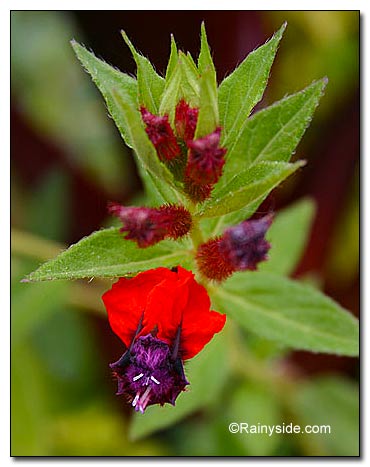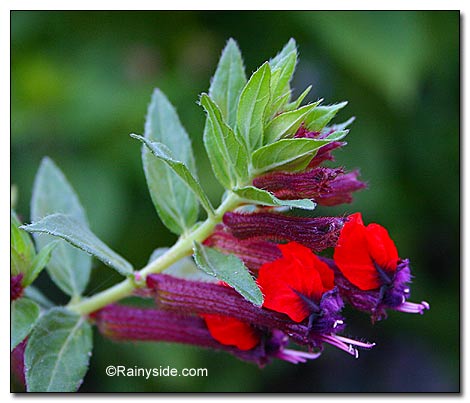Cuphea llavea 'Georgia Scarlet'
BAT-FACED CUPHEA, TINY MICE CUPHEA
Family: Lythraceae
Pronounced: KEW-fee-ah LAY-vee-ah
Quick Jumps
Growing Guide
Rainy Side Notes
GROWING GUIDE

Origin:
Garden.
Plant Group:
Tender subshrub, treated as an annual in the Pacific Northwest.
Hardiness:
Sunset zones: 11-13, 21-24, H1, H2. Annual in colder zones.
USDA zones: 10-15.
Mature size:
Height: 1-2 feet (45-60 cm).
Width: 2 feet (60 cm).
Flowering period:
Spring to autumn.
Flowering attributes:
Hairy, violet, tubular flowers with purple ends and two brilliant red petals, held on one-sided racemes.
Leaf attributes:
Hairy, lance-shaped, green leaves.
Growth habit:
Clump forming.
Light:
Full sun.
Soil:
Fertile, moist, well-drained soil.
Feeding:
Add a complete organic fertilizer when planting in the ground. Add additional fertilizer monthly. In containers use a timed-release fertilizer or apply monthly applications of liquid fertilizer.
Propagation Methods:
Divide in late spring.
Softwood cuttings in late spring.
Pruning:
Prune over-wintered plants in early to mid spring. Do not cut back into bare wood.
Pests and Diseases:
Aphids and white fly may be problematic, especially when wintered over in the greenhouse. Cupheas are prone to root rot and powdery mildew.
Rainy Side Notes

When I purchased my first Cuphea llavea 'Georgia Scarlet', I didn't know its common name. Peering into its first flower, I saw the face of a bat gazing back at me. It isn't sinister like a creature from a horror movie. It looks more like a cartoon character that would tickle your fancy, not bite your neck. It is clear, its common name, bat-faced cuphea, describes it perfectly.
I grow cupheas in containers and over winter them in my greenhouse. However, they are suitable for growing as an annual. Planting a 4-inch pot size, it will quickly grow into a nice size plant, blossoming most of the summer until first frost. Since cupheas are a desert plant, you assume it would be drought tolerant. But no-oh, this little beauty, in its native haunts, grows close to streams, requiring moist yet well-drained soil. You know, that perfect soil we are constantly striving to achieve in our gardens? Yes, that is the soil it needs.
Cuphea originates from the Greek word, kyphos, meaning curved, denoting its curved seed capsule. At the University of Georgia, Casimir Jaworski and Sharod Phatak bred the species that brought out the purple calyx on a compact shrub. They were breeding it as a source of medium-chain fatty acids. They called it 'Georgia Scarlet'. There is some confusion as to its name. I was informed of a selection registered as Tiny Mice came originally from an Australian breeder. For the moment, the best information I have is the cultivar name is Cuphea 'Georgia Scarlet'. As soon as I find more information on this, I will make any necessary updates.
Prone to root rot, it is crucial to water cupheas sparingly throughout the winter months.
Debbie Teashon
Photographed in author's garden.

Gardening for the Homebrewer: Grow and Process Plants for Making Beer, Wine, Gruit, Cider, Perry, and More
By co-authors Debbie Teashon (Rainy Side Gardeners) and Wendy Tweton
Copyright Notice | Home | Search | Annuals

